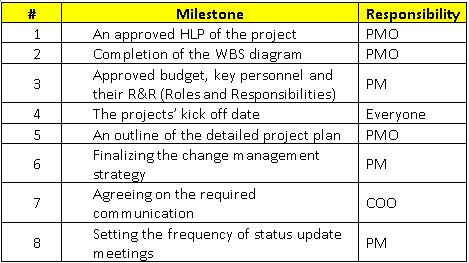Schedule Management Plan
Schedule Management Plan
A Schedule Management Plan (SMP) is a document which outlines how the plan for a project will be created and maintained. It is basically a roadmap of how to plan the project, and how to maintain the plan once the project has started.

Maintaining the plan includes: identifying changes, analyzing their impact, documenting and communicating the change throughout the project (team members and key stakeholders).
The SMP is traditionally written by the PMO, while working closely with the key stakeholders and the projects’ management directorate. In many cases it is approved by the board of directors or CEO of the company.

Schedule Control –
This paragraph of the SMP defines how the schedule will be maintained after the project’s kick off. It covers the following areas –
- The frequency of the meetings where each task of the plan will be updated with the estimated start / end date, the % complete and the allocated resources. For example: once every 2 weeks for the business teams, and once a week for the IT teams.
- Who will lead and attend each meeting. This should include the roles only, not the actual names of the team members.
- The expected output, and the impact that they have on the schedule. This should include the template of the meeting MoM (Minutes of Meeting), and how the impact will be analyzed and estimated.
- Who can approve the changes. Specify which role(s) is qualified to approve them.
- How the changes will be communicated throughout the project. Agree on a template of how the changes will be recorded, and the medium of which it will be relayed to the key stakeholders and the team members.

Scope Control –
This section of the SMP defines how the changes to the scope of the project will be made and communicated. It covers the following areas –
- Specifies who is authorized to approve the scope change. This is usually one of the key stakeholders or the projects’ sponsor.
- Outlines how the scope change will impact the timeline, budget, resources, etc. of the project.
- Defines whether the scope change warrant a re-baselining of the KPI’s for the measurements listed above (bullet point #2 of the scope control).
- Deliverables scope change: Defines if the scope change impacts the deliverables that the project is intended on fulfilling.
- Documenting the changes: It is very important to clearly state what led to the scope change, where the project was before the change and where it is after. This will be useful for the post-delivery analysis, and for creating a lessons learned for the company.



